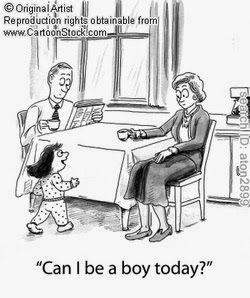Monday, December 8, 2014
Introducing Gender
Every day children are exposed to gender expectations. These expectations are presented to them in a multitude of media. Aside from these different mediums that will be discussed within the blog, children are exposed to gender expectations by different adult role models that are present in their lives. In some instances a child who grows up in a “single mother household” may take on aspects that are deemed feminine as well as those that are masculine. Whereas a child who has two opposite sex parents in their home may only take on their specific gender roles. Every child, every household, and every outcome is different.
Gender Expectations in Advertisement
The medium we will pay attention to is print and television advertisement. Companies play into our society’s gender expectations when presenting, let’s say, an advertisement for a Disney Princess doll or Power Rangers action figure. In the images below you can see a young male child playing with a Power Rangers toy and another playing with a Star Wars Lightsaber. Both of these franchises in fact have female characters so the question arises “Why do they not depict young female children playing with the female character counterparts?” The implication within these types of advertisement is that girls are not “into” Star Wars or Power Rangers because these are “boy’s toys.”
(Target Ad October 26-November 26, 2014)
(Target Ad October 26-November 26, 2014)
Femininity and Masculinity
The one thing I believe the media “gets right” is the fact that both boys and girls use pretend play as creative outlets. However they once again show boys in what are said to be masculine roles, such as the young fireman below. And as usual girls are depicted in what are said to be feminine roles much like the image of the princess standing near a vanity table, which sends it’s own message about the female persona, which we will not cover within this blog.
(Target Ad October 26-November 26, 2014)
(Target Ad October 26-November 26, 2014)
Bully: The Expectation Mediator
Peers often bully some children who do not fit into their gender specific expectations. As a result of this some children suffer through identity crisis and want to change the things that they do and like based upon the thoughts of their peers and “so-called” friends.
I take from a personal experience of my own, a lesson in the importance of teaching children to be whom they want to be regardless of outside influence. My daughter, a 6-year-old first grader, was the victim of bullying because of gender expectations. Before the school year began we participated in our normal back-to-school shopping. As always I allowed her to pick her backpack and lunch box. It just so happens that within the previous months she had become a fan of Skylanders Swap Force, which is a game she often played with her father and brother. She ultimately chose a Skylanders backpack and matching lunch box (shown below). As a result of this choice, she would report home crying that children at school were calling her a boy because she had “a boy’s backpack.” She felt as though it was necessary to change and purchase a new backpack so that she could keep her friends from talking about her. I made it my point not to waiver to this request but instead to teach her a valuable lesson in self worth and friendship. “If they cannot accept you and respect what you like then they are not the type of friends you need.”
A Child's Perspective
An interview I conducted with my daughter about gender expectations and her personal experience and feelings.
Q: What kinds of toys do you like?
A: Umm
Transformers, robot toys, dinosaur toys like on Doc McStuffins, dragon toys,
play food, remote control toys, adventure toys.
Q: What do you mean adventure toys?
A: Like,
those army toys.
Q: Would you call those girl toys, boy toys, or just toys that you like?
A: Those
are toys that I like.
Q: How does it make you feel when someone teases you and tells you those are boy’s toys?
A: Umm,
it makes me feel sad.
Q: Why does it make you feel sad?
A: Because
I don’t like when people tease me.
Q: Do you think everyone should be able to like any thing they want?
A: Yes
Q: Why do you think that?
A: Because
they want it and that’s all that matters.
Q: Do you like princess toys too?
A: Yes
Q: When you were teased about your backpack, what did you want to do about it?
A: I
wanted to change the people that were teasing me.
Q: Did you want a new backpack?
A: Yes
Q: Why?
A: Because
I don’t like it when people tease me.
Q: It’s not your fault or your backpack’s fault that people tease you. Do you know whose fault it is?
A: Their
fault, or probably our parent’s fault, I don’t know which one it is.
Q: Why?
A: Because
they’re the one’s that were teasing me and it wasn’t nice.
Subscribe to:
Comments (Atom)







